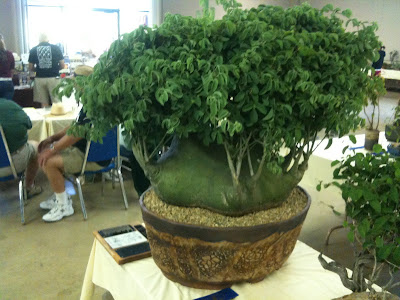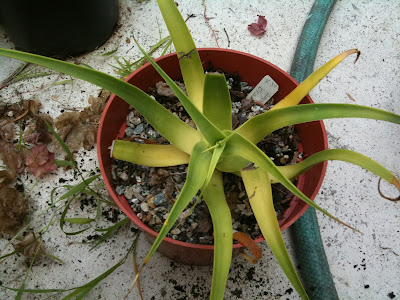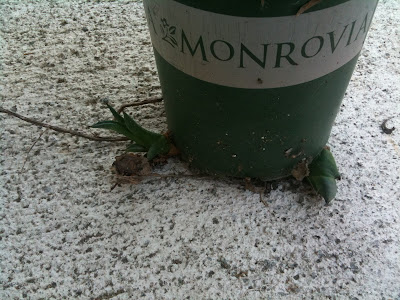I went to the Inter City Cactus and Succulent show and sale at the L.A. Arboretum on Saturday. I like both the show and the sale because you get to see amazing specimen plants that you can likely find outside for sale.
This is the third year that I've gone and some of the show plants are becoming familiar. This one is hard to forget and is quite a crowd pleaser.

Abromeitiella brevifolia. I'm not sure how long it took for this plant to grow its perfect round form or what it looks like on the inside but it wins an award every year.
I like the show because I get to see so many beautiful plants that I've never heard of.

Gasteria sp.
You can also see plants in their peak condition. I don't know if I've ever seen Lithops looking so juicy and happy. (Some of my photos flipped when I uploaded them and I didn't have the time to fix it. Hopefully you can still get the gist)

Lithobs Leslie rubrobronnea

Lithops hookeri

Lithops mormorata
Pachipodium lamerii is one of my favorites. It's a pretty easy-to-find plant these days but when I first came across it in a Home Depot 14 years ago it blew my mind. It looked like a cross between a mini palm tree and a cactus. I've been accumulating little pachipodiums for years with the intention of planting a little forest of them. I haven't found the right place yet so they're all still in pots.

This group was labeled "Rubetia, Sulcorebutia Weingartia Cluster." I'm not sure that that is but I love how they look like bowls of fruit.

The show is a big draw for photographers that are much more adept than I am with my iphone camera.

This was the winner for "Best Caudicial" That caudex must weigh 30 pounds.

Adenia glauca
There were also some nice surprises like this Crassula pellucida.

The new growth is a bright green while the older growth changes to burgundy.

There were a couple of different groups for agaves. This was the "Under 6" group. It's too bad that giant agaves can't be represented at the show, but these more portable young and miniature types still give good face.

I had already been through the sale outside and made my selections so it was nice to see some of the species here on the show table.

Agave stricta nano. I'm assuming "nano" means this is a small variety.

Agave aplanata

Agave felifera compacta

Agave felifera "Black Widow"
I was a little confused by these next two plants. This one was called Agave kichijokan.

And the second was called Agave potatorum "kichiokan". I've tried to faithfully copy the names but the similarity of the spellings makes me wonder if these are both varieties of potatorum called "Kichiokan". A quick internet search doesn't turn up any Kichiokans without referencing potatorum. San Marcos growers describes this as a Japanese variety of potatorum with the variegated form being called "Kissho Kan" a name I've come across before. I'm curious because I love potatorum, but more on that later.

I also fell in love with this little agave, Agave potonii compact variegated. I like the contrast of the dark green and the creamy yellow. Potonii is one that I hadn't picked up at the sale but I thought I had seen a few. When I went back out to look for one though I couldn't find any. There was a hybid with parryi but I really wanted a nice tight compact plant like these.

There are always some nice Agave iophanthas at the show. There are usually tricolors and even a quadcolor once, I think the fourth color was meant to be the dark red teeth on the margin. This one below is relatively subdued by comparison but still has nice distinct markings.

Specimen level Agave victoria reginae always make me smile. What a happy plant.

Agave "Blue Glow" is popular and offered for sale by a few of the vendors. I had one of these in my box as I walked through and people kept asking me about it. Luckily there seemed to be enough to go around.

This is an agave that I've never seen or heard of. Based on the name Agave Joe Hoals hybrid it might be a happy accident. I not sure if it shows in the photo but it had a beautiful satiny sheen and cool minty color that really made it stand out. I don't know who Joe Hoal is but I might need to track him down.

Agave gentryi "Jaws" is another fun one. I like the young plants where the teeth are so large in proportion to the leaves.

So this was my haul. It turned out that I only had eyes for agaves.

I stuck with mostly small plants but they are all healthy little guys that looked packed with kinetic energy, ready to explode. Here's the "Blue Glow" that everyone wanted.


Agave stricta nano. This plant was a little worn from it's journey but it cleaned up nicely and already has an offset.

Agave applanata variegata. The applanata I saw in the show looked very similar to a potatorum so we'll see how it develops as it gets older.

Agave kichiokan. Again it's just labeled as "kichiokan" but maybe it should be potatorum var "kichiokan".
Agave montana. I first heard about this plant from
photo tour of Mexico from Oasis Designs. They had pictures of
mature montanas in it's natural habitat that were spectacular. My little plant is only about 4" across but it already has the beautiful imprints that make some montanas so distinct.

It turns out that I'm not discriminating at all when it comes to agaves, I like them all, eg. Agave utahensis. It doesn't get that big, it can't claim a dramatic color or pattern, in the wild it tends to look a little withered, but it's a survivor. It offset a lot, creating a dense bed of thorny tenacity. Again, my plant is tiny, but in 20 or 30 years it will be a plant to be reckoned with.

I also finally got an ovatifolia which I've been craving since seeing Pam Penick's at
Digging.

I'd read that ovatifolia doesn't offset but this one already has a pup. My friend John said that one of his is offsetting as well. I'll keep an eye on it. Maybe it's an impostor.

This is a hybrid of two of my favorites, Agave colorata x bovicornuta. It's possible that the things I like will cancel each other out. The colorata is ghostly pale while bovicornuta is known for it's luminescent green and orange. But for $5 I'm willing to give it a try. The leaves already have a nice shape and it seems to be growing fast.

I don't know how it happened but a non-agave got in my box.

This Pedilanthus macrocarpus reminds me a little of euphorbia tirucalli but it gets a pretty wicked looking flower:

So after seeing Agave potonii in the show but being unable to find it for sale I figured I'd just have to add it to my wish list and be patient. I didn't have long to wait. It turns out that I had already got it at last year's Inter City show. My agave avarice is apparently more dependable than my memory: Agave potonii minima variegate

I never posted about the plants I got last year so I guess I'll do it now. It was almost all agaves last year too.

I thought that this was my first Agave potatorum but it turns out that I could be wrong. A couple of years ago I got a plant at
Worldwide Exotics in Sylmar, CA. They called it Agave pygmaea but it didn't look much like other pygmaeas I could find or Agave seemanniana ssp pygmaea as the Huntington calls it. Here it is. I could be wrong but it looks more like a potatorum to me. In a few more weeks I might have more information to go on. As you can see, it's starting to bloom. I never even got a chance to get it out of the pot. Potatorum should have light green flowers while ssp pygmaea's are described as bright yellow.

The spike has grown about 3 feet in the last week.

I had already pulled a bunch of pup off of it and given a couple away. I wish I could be sure what they are.

Last year at the show I also got this little Agave bracteosa. It looks like it's getting a little too much sun and last summer's crop of chicks had a tendency to stomp all over it so some of the leaves are a bit ragged but it's putting out a lot of new growth.

Agave colorata with a couple tiny pups.

Agave macroculmis

This is another Mexican agave you can see on Oasis Design's
tour. They talk about seeing macroculmis, gentryi, and monatana all growing in the same habitat and seeing many hybrids of all three. It makes me wonder how sure we can be where one species ends and another begins. I have a lot of respect for taxonomists but part of their process seems to be the constant reevaluation of names where species are combined or differentiated based on the most current information. Maybe my blooming pygmaea is really a potatorum or scolymus or guatamalensis. It might just depend on who you talk to.
There's a part of me that appreciates accuracy in nomenclature and it's comforting to know the names of things, but a plant's muddy geneology doesn't keep me from enjoying it. I'm satisfied with whatever personal history I can create for them: where I got them, how long I've had them, if they've had good years or bad, where they a gift, did they fall over in the heavy winds of 2008? I strive to be a rigorous gardener but that will only ever be an aspiration. I'm much too messy.
There were a couple of non-agave's last year too. Both of them purchased after I saw an especially nice specimen in the show.
I've always loved the medusoid euphorbias but have found them difficult to grow. I haven't managed the knack yet of helping them to flourish. This Euphorbia flananigani is doing well so far, but we've only just started our relationship together.

I'd never seen an aloe like this Aloe arenacola. The ones in the show were upright but mine has decided to take it easy and lay down. I like a nice nap myself so I won't fuss with it.

Since I'm reporting on all my past shopping maybe I should finish it all up. I have a few plants from the last Huntington sale as well.

Agave tequiliana "Sunrise"

Agave potatorum "Cream Spike." I'm not crazy about variegated agaves unless the yellow is very pale. I like words like "Cream" and "Medio picta alba." Hopefully this one will stay pale.

Magave "Macho Mocha"

Dyckia platyphylla. There were some great dyckias in the Inter City show and a few for sale but they were more than I wanted to spend. They were more likely to be $20 rather than the $5 or 6 that I paid for the baby agaves. I managed to get this dyckia at the Huntington for only $10.

Members of my future Pachypodium lamerii forest.
Here's another plant that I got at Worldwide Exotics. I mentioned above that they play a little fast and loose with names sometimes. They told me that this was Agave gentryi....or ferox. They do look a little similar when they are small but a ferox can be twice as big as a gentryi, up to 12' across. I guess I should just find a place with plenty of room to spread out. They are supposed to do well on hills, and I have plenty of hill.

This plant is a little contorted right now because it was in the middle of the scrum of my staging area (aka my front yard) and it has a few pups struggling for space. Even bursting out the bottom. I'm glad I pulled this plant out to take a look. I'll cut it out and move it to a more comfortable spot.

I'll get back to you in 10 years on whether it's gentryi or ferox.
I have some other new plants rattling around but those were all of the big shopping trips lately. I would much rather have things in the ground but I've been waiting because I'd like to build some small retaining walls to create some tiers climbing the hill. All of these plants are drought tolerant but it take a while for them to become established and it's hard to water on a hill. Maybe I should move them all up a size in pots just in case it take me years to get them in the ground.






























































